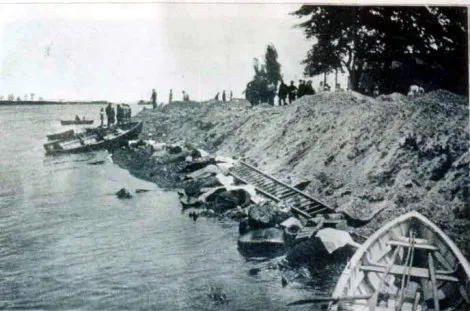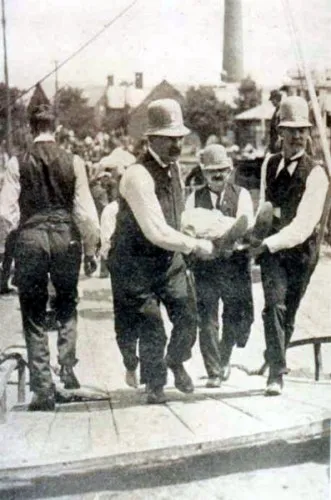A Spectacle of Horror – The Burning of the General Slocum
The deadliest disaster in New York before 9/11 killed many women and children and ultimately erased a German community from the map of Manhattan
/https://tf-cmsv2-smithsonianmag-media.s3.amazonaws.com/filer/20120221012102general-slocum.jpg)
It was, by all accounts, a glorious Wednesday morning on June 15, 1904, and the men of Kleindeutschland—Little Germany, on Manhattan’s Lower East Side–were on their way to work. Just after 9 o’clock, a group from St. Mark’s Evangelical Lutheran Church on 6th Street, mostly women and children, boarded the General Slocum for their annual end-of-school outing. Bounding aboard what was billed as the “largest and most splendid excursion steamer in New York,” the children, dressed in their Sunday school outfits, shouted and waved flags as the adults followed, carrying picnic baskets for what was to be a long day away.
A German band played on deck while the children romped and the adults sang along, waiting to depart. Just before 10 o’clock, the lines were cast off, a bell rang in the engine room, and a deck hand reported to Captain William Van Schaick that nearly a thousand tickets had been collected at the plank. That number didn’t include the 300 children under the age of 10, who didn’t require tickets. Including crew and catering staff, there were about 1,350 aboard the General Slocum as it steamed up the East River at 15 knots toward Long Island Sound, headed for Locust Grove, a picnic ground on Long Island’s North Shore, about two hours away.
Built in 1891 and owned by the Knickerbocker Steamboat Company, the General Slocum was made of white oak, locust and yellow pine and licensed to carry 2,500 passengers. The ship carried that many life preservers, and just a month before a fire inspector had deemed its fire equipment to be in “fine working order.”
As the ship reached 97th Street, some of the crew on the lower deck saw puffs of smoke rising through the wooden floorboards and ran below to the second cabin. But the men had never conducted any fire drills, and when they turned the ship’s fire hoses onto the flames, the rotten hoses burst. Rushing back above deck, they told Van Schaick that they had encountered a “blaze that could not be conquered.” It was “like trying to put out hell itself.”

Onlookers in Manhattan, seeing the flames, shouted for the captain to dock immediately. Instead, Van Schaick, fearing the steering gear would break down in the strong currents and leave the Slocum helpless in midriver, plowed full speed ahead. He aimed for a pier at 134th Street, but a tugboat captain warned him off, fearing the burning ship would ignite lumber stored there. Van Shaick made a run for North Brother Island, a mile away, hoping to beach the Slocum sideways so everyone would have a chance to get off. The ship’s speed, coupled with a fresh north wind, fanned the flames. Mothers began screaming for their children as passengers panicked on deck. As fire enveloped the Slocum, hundreds of passengers hurled themselves overboard, even though many could not swim.
The crew distributed life jackets, but they too were rotten. Boats sped to the scene and pulled a few passengers to safety, but mostly they encountered children’s corpses bobbing in the currents along the tidal strait known as Hell Gate. One newspaper described it as “a spectacle of horror beyond words to express—a great vessel all in flames, sweeping forward in the sunlight, within sight of the crowded city, while her helpless, screaming hundreds were roasted alive or swallowed up in waves.”
A witness reported seeing a large white yacht flying the insignia from the New York Yacht Club arrive on the scene just as the burning Slocum passed 139th Street. He said the captain positioned his yacht nearby and then stood on the bridge with his field glasses, “seeing women and children jump overboard in swarms and making no effort to go to their assistance…he did not even lower a boat.”
Passengers trampled children in their rush to the Slocum‘s stern. One man, engulfed in flames, leaped over the port side and shrieked as the giant paddle wheel swallowed him. Others blindly followed him to a similar fate. A 12 year-old boy shimmied up the ship’s flagstaff at the bow and hung there until the heat became too great and he dropped into the flames. Hundreds massed together, only to bake to death. The middle deck soon gave way with a terrific crash, and passengers along the outside rails were jolted overboard. Women and children dropped into the choppy waters in clusters. In the mayhem, a woman gave birth—and when she hurled herself overboard, her newborn in her arms, they both perished.
At Riverside Hospital on North Brother Island, where patients with typhoid and other contagious diseases had been quarantined, staff spotted the burning vessel approaching and quickly prepared the hospital’s engines and hoses to pump water, hoping to douse the flames. The island’s fire whistle blew and dozens of rescuers moved to the shore. Captain Van Schaick, his feet blistering from the heat below, managed to ground the Slocum sideways about 25 feet from shore. Rescuers swam to the ship and pulled survivors to safety. Nurses threw debris for passengers to cling to while others tossed ropes and life preservers. Some nurses dove into the water themselves and pulled badly burned passengers to safety. Still, the heat from the flames made it impossible to get close enough as the Slocum became engulfed from stem to stem.

Firefighter Edward McCarroll dove into the water from his boat, the Wade, and pulled an 11 year-old girl to safety, passing her to a man with a boat hook. He went back for another when one woman grabbed him by the throat, pulling him under water momentarily, and shouted, “You must save my boy.” McCarroll dragged the child to the Wade, and they were both hoisted aboard. Crews from tugs following the Slocum were credited with pulling in the living and the dead “by the dozen.”
Within an hour, 150 bodies were stretched out on blankets covering the lawn and sands of North Brother Island. Most of them were women. One was still clutching her lifeless baby, who was “tenderly taken out of her arms and laid on the grass beside her.” Rescued orphans of 3, 4 and 5 years old milled about the beach, dazed. Hours would pass before they could leave the island, many taken to Bellevue Hospital to treat wounds and await the arrival of grief-stricken relatives.
Van Shaick was believed to be the last person off the Slocum when he jumped into the water and swam for shore, blinded and crippled. He would face criminal charges for his ship’s unpreparedness and be sentenced to 10 years in prison; he served four when he was pardoned by President William Howard Taft on Christmas Day, 1912.
The death toll of 1,021, most of them women and children, made the burning of the Slocum New York City’s worst disaster until the attack on the World Trade Center on September 11, 2001. The fire was believed to have been touched off by a carelessly tossed match or cigarette that ignited a barrel of packing hay below deck. There were also remarkable tales of survival. A 10-month-old boy floated to shore, uninjured but orphaned, and lay unclaimed at a hospital until his grandmother identified him days later. Eleven-year-old Willie Keppler had joined the excursion without his parents’ permission but made it through the flailing of non-swimmers who dragged fellow passengers down with them; he was too scared of punishment to return home until he saw his name among the dead in the next day’s newspaper. “I thought I’d come home and git the licking instead of breaking me mudder’s heart,” Keppler was quoted as saying. “So I’m home, and me mudder only kissed me and me fadder gave me half a dollar for being a good swimmer.”
The men of Little Germany were suddenly without families. Funerals were held for more than a week, and the desolate schoolyards of Kleindeutschland were painful reminders of their loss. Many widowers and broken families moved uptown to Yorkville to be closer to the scene of the disaster, establishing a new Germantown on Manhattan’s Upper East Side. Some returned to Germany. Before long, Kleindeutschland disappeared under New York’s next wave of Polish and Russian immigrants.
Sources
Articles: “One Man Without a Heart,” Chicago Daily Tribune, June 16, 1904. “Recover 493 Dead,” Boston Globe, June 16, 1904. “Captain of Boat Tells His Story,” Chicago Tribune, June 16, 1904. “East Side’s Heart Torn By the Horror,” New York Times, June 16, 1904. “General Slocum Disaster,” http://www.maggieblanck.com/Goehle/GeneralSlocum.html. “A Brief Account of The General Slocum Disaster,” by Edward T. O’Donnell. http://www.edwardtodonnell.com/ also, http://www.politicsforum.org/forum/viewtopic.php?f=69&t=59062.
Books: Edward T. O’Donnell, Ship Ablaze: The Tragedy of the Steamboat General Slocum, Broadway, 2003.
/https://tf-cmsv2-smithsonianmag-media.s3.amazonaws.com/accounts/headshot/gilbert-king-240.jpg)
/https://tf-cmsv2-smithsonianmag-media.s3.amazonaws.com/accounts/headshot/gilbert-king-240.jpg)